Moorhens in Alexander Park
Moorhens in Alexandra Park – Kenneth Overend
Moorhens are on ponds and lakes throughout Alexandra Park. At present, though, there are fewer than usual in the upper part of the park, both in the Shornden and the Buckshole areas.
They are dark birds with a white broken streak on their sides and their red beaks have a yellow tip. Their legs are greenish yellow and when they walk their feet have the habit of crossing each other. When they swim they constantly nod their heads forward rather like pigeons when they are walking. They look black from a distance, but actually their wing feathers are olive-brown and their bodies blue-grey. In their early days their heads have a red speckled appearance. The red is their scalp. Their overall appearance at this stage is sooty black. In the second stage they look brown, and in the mature state they look black – unless you are close to them.
They build their nests by water and usually build more than one during the breeding season. The work they put into the building makes one feel they deserve to breed successfully. The parents take it in turns to brood the eggs. In 2007 the two moorhens on the Buckshole feeder pond at the entrance to Coronation Wood successfully reared 18 chicks. For me that’s a record. The first brood hatched in the first week of April and six survived; the second brood seven weeks later and five survived; and the third around the middle of July and seven survived. Why intervals of seven weeks? Perhaps because that’s about how long before the young can fly.
As soon as mallards hatch they have to feed themselves – the mother duck’s beak is not suited to feeding them, any more than to building a nest. But in the first two to three weeks moorchicks can’t feed themselves; they have to be fed plankton beak to mouth by the parents, and also they relish bread, but it should not be thrown in the presence of ducks and gulls, and should be the sort of bread usually frowned upon, soft and unseeded, as the chicks are not yet ready to take seed.
Later the parents drop the food in front of the chicks to encourage them to fend for themselves. Some of the first brood stay on as additional parents, and likewise the second brood. I’ve seen an adult pass bread to a youngster who then passed it on to a younger youngster – a relay enterprise outwitting the ducks.
Predators include rats, cats, crows, gulls, herons and terrapins. Also against young moorhens are floodwater and clearance.
Since 2007 the site of the pond by the entrance to Coronation Wood has undergone such changes that the pond is no longer a pond. There has been clearance in the purported interest of conservation. But clearance can bring about deprivation and conservation become a misnomer. Each breeding season in recent years moorhens have tried to raise families there but have had scant success. This year the remaining two moorhens deserted the site.
The initial problem was that clearance deprived moorhens of bankside vegetation. The instinct to breed was there but they did not have the material to build a sturdy nest in a suitable spot. Moorhens, unlike mallards, refuse a ready-made nest. But they need the raw material. Vegetation offers building material, nest site, sustenance and protection. This last is of particular importance because the park has a greater concentration of predators than the open countryside.
The smallest pond in the park is just above the old boating lake. There is an islet on this pond. Every year two moorhens successfully raise a family there. There is a shrub on the islet. Without that shrub for protection it is doubtful whether any chicks would survive – indeed doubtful whether they would have the opportunity to hatch.
Last year the vegetation on the inner walls of Shornden Reservoir was shorn during the breeding season. Some moorchicks had been using the vegetation as protection. They disappeared. The implication is obvious: such shearing should take place outside the breeding season.
I quote from the RSPB Handbook of British Birds on the subject of moorhens: Potential threats come from the methods of managing waterways that often remove bankside vegetation.
Kenneth Overend, October 2013.
Photos by John Harrison.


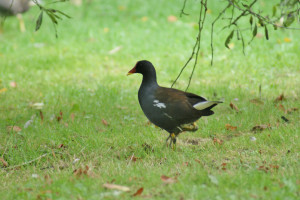
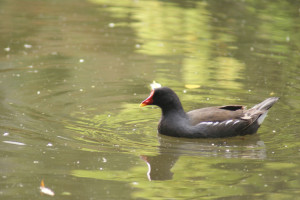
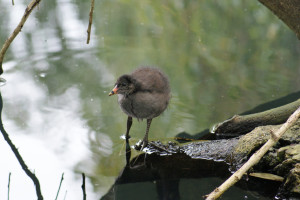
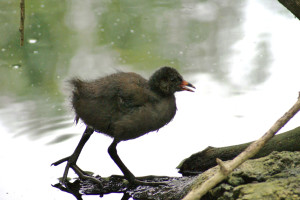
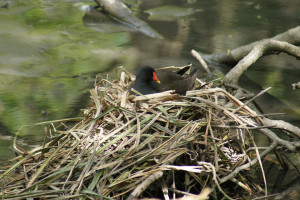
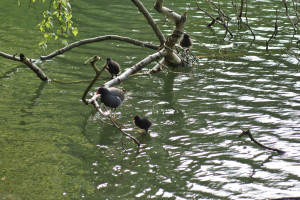
I see my English teacher has lost none of his poetic skill. I have you to thank for my own teaching career Mr. Overend. I found the information here in keeping with my own experience; the Moorhens of Bradbourne Lakes in Sevenoaks delightfully outwit the mallards with a gleeful regularity. Thanks for everything Ken, good to see you still have the unruly mop of hair…
Wonderful words, Ken, and brilliant pictures. As always there is something to learn from you! But the pic of you could be better… I’ll send the editor ones I have and everyone can see Ken Overand as he really is!
Thank you for your very informative article and lovely photos about Moorhens in Alexandra Park. Their fight for survival touched my heart and I wonder what can be done to help them have a successful breading season in our beautiful park. Do we need to lobby for these lovely creatures, set up a Moorhen support group?